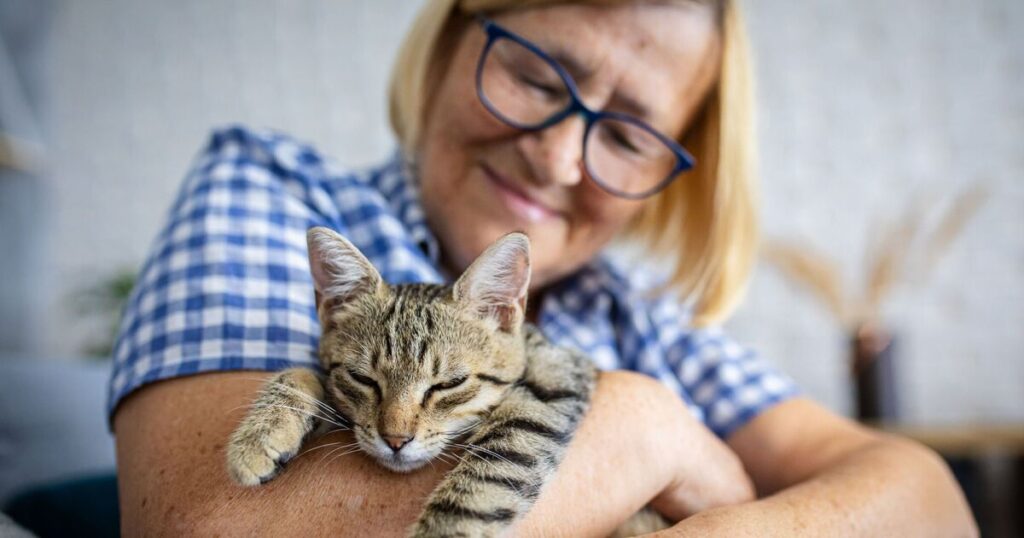
Cat owners have been warned to beware of the eight key signs your pet’s developing dementia – after recent studies confirmed they also develop the brain-aging condition. A recent paper, published in the European Journal of Neuroscience, even found many similarities between feline and human dementia, concluding cognitive impairment may develop in similar ways.
Feline cognitive dysfunction syndrome (also known as feline dementia) is an age-related decline in a cat’s cognitive abilities. It’s generally characterised by behavioural changes that cannot be attributed to other medical conditions. Some of the symptoms of dementia in cats are strikingly similar to what we might see in humans so knowing what signs to look out for is important, to help provide your puss with the best care.
It is thought to be very common in older cats with one study finding that by 15 years of age, more than half of cats showed signs of dementia – but some signs were also identified in cats as young as seven.
A separate cat owner survey also found around 28 per cent of cats, aged between 11 and 14, exhibited at least one behavioural change associated with dementia.
Scientists at the University of Edinburgh say cats showing dementia symptoms – such as confusion, sleep disruption and more meowing – have brain changes similar to those in people with Alzheimer’s.
Studying feline dementia also has the potential to help develop human treatments because the condition between the two species is so similar.
Now in The Conversation, two experts at the University of Bristol – Emily Blackwell, senior lecturer in animal behaviour and welfare and Sara Lawrence-Mills, postdoctoral researcher at Bristol Veterinary School – have listed eight warning signs to spot:
1. Unusual vocalisation: Your cat might start to vocalise excessively, or in new situations. A common example of this is meowing loudly at night.
2. Altered interactions: Cats with dementia sometimes seek attention more often or become “clingy”. Equally, cats with dementia might interact less than previously, appear irritable or seem not to recognise familiar people.
3. Sleep changes: You may notice changes in your cat’s sleeping habits – often becoming restless at night and sleeping more during the day.
4. House soiling: Changes in toilet habits can be a sign of several different conditions, but toileting outside the litter tray can be a common sign of dementia in cats.
5. Disorientation: Just like people with dementia, cats may show signs of confusion or wandering behaviour. This might appear as losing their bearings, staring blankly at walls, getting stuck behind objects or going to the wrong side of the door.
6. Changes in activity levels: A cat with dementia may be more or less active than usual. They may play less often or be less inclined to explore. You might also notice them spending less time taking care of themselves, for example grooming or washing themselves less.
7. Appearing anxious: A cat with dementia might show signs of anxiety in situations that they were previously confident with – such as around familiar people, places or sounds. An anxious cat might hide more often, going under the bed or on top of cupboards to escape.
8. Learning problems: Cats with dementia may be less unable to perform previously learned tasks, such as finding their food bowl, and may have difficulty learning new tasks.
Caring for your cat:
There’s significant overlap between symptoms of feline dementia and other common conditions, such as arthritis and kidney disease.
So if you see any of these behavioural changes in your cat, you should speak to your vet to rule out these other conditions.
Research into feline dementia is limited. Much of what we know about prevention and treatment is extrapolated from research into humans and dogs.
And, as with these other species, there’s no cure for dementia in cats. But there are ways of limiting the impact of the disease.
Certain environmental modifications can help stimulate cats, activating their brains and causing nerves to grow. But the severity of your cat’s dementia must be considered before making any of these changes.
In healthy or mildly affected cats, promoting play or simulating hunting with interactive toys and encouraging exploration using hide and seek games is thought to delay the progression of cognitive dysfunction.
But in cats with severe cognitive impairment, changing their environment could lead to confusion and anxiety – worsening behavioural symptoms.
Diet changes – specifically the addition of supplements containing antioxidants (vitamin E and C) and essential fatty acids – may also help to reduce inflammation in the brain, slowing the disease’s progression.
However, only dog-specific supplements have been tested in scientific research and proven to enhance cognition in dogs.
But if you do want to try giving these supplements to your cat, be sure you only give them supplements approved for felines.
Dog supplements should not be given to cats as they may include substances that are toxic to cats – such as alpha lipoic acid.
Feline dementia is a condition both highly prevalent and challenging to manage. Knowing what symptoms to look out for can ensure your cat gets diagnosed earlier on.
This will also ensure you’re able to make the necessary changes to its environment or diet that will ultimately improve its quality of life.
